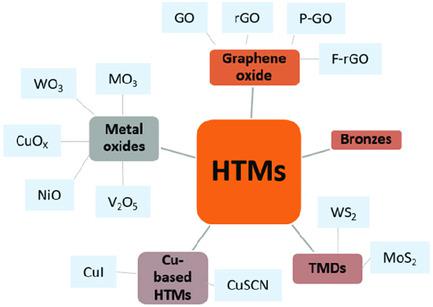Our official English website, www.x-mol.net, welcomes your
feedback! (Note: you will need to create a separate account there.)
Robust Inorganic Hole Transport Materials for Organic and Perovskite Solar Cells: Insights into Materials Electronic Properties and Device Performance
Solar RRL ( IF 6.0 ) Pub Date : 2020-11-13 , DOI: 10.1002/solr.202000555 Azhar Fakharuddin 1 , Maria Vasilopoulou 2 , Anastasia Soultati 2 , Muhammad Irfan Haider 3, 4 , Joe Briscoe 5 , Vasileios Fotopoulos 5 , Diego Di Girolamo 6 , Dimitris Davazoglou 2 , Alexander Chroneos 7 , Abd. Rashid bin Mohd Yusoff 8 , Antonio Abate 6, 9, 10 , Lukas Schmidt-Mende 1 , Mohammad Khaja Nazeeruddin 11
Solar RRL ( IF 6.0 ) Pub Date : 2020-11-13 , DOI: 10.1002/solr.202000555 Azhar Fakharuddin 1 , Maria Vasilopoulou 2 , Anastasia Soultati 2 , Muhammad Irfan Haider 3, 4 , Joe Briscoe 5 , Vasileios Fotopoulos 5 , Diego Di Girolamo 6 , Dimitris Davazoglou 2 , Alexander Chroneos 7 , Abd. Rashid bin Mohd Yusoff 8 , Antonio Abate 6, 9, 10 , Lukas Schmidt-Mende 1 , Mohammad Khaja Nazeeruddin 11
Affiliation

|
Interfaces in perovskite and organic solar cells play a central role in advancing efficiency and prolong device durability. They improve charge transport/transfer from the absorber layer to the collecting electrodes, while also blocking the opposite charge carriers, minimize voltage losses by suppressing charge recombination. and may act as buffer/protective layers and nanomorphology regulators for the absorber layer. One such interface is formed by the hole transport layer (HTL) and the organic/perovskite absorber. These HTLs typically consist of organic semiconductors, which, although are solution processable at low temperatures and allow perfect energy‐level alignment with the absorber layer and therefore efficient charge collection, are prone to degradation in ambient conditions and under continuous light exposure. In a quest for robust alternatives, inorganic materials such as metal oxides, graphene oxide, bronzes, copper thiocyanate, and transition metal dichalcogenides are actively investigated. However, their hole extraction capability is inferior compared with organic semiconductors as they possess specific energetics leading to significant charge extraction barriers and moderate charge collection. To achieve further advancements in their hole transporting capabilities, strongly interconnecting knowledge of their synthesis, electronic properties, and device performance metrics is required.
中文翻译:

用于有机和钙钛矿太阳能电池的坚固的无机空穴传输材料:对材料电子特性和器件性能的见解
钙钛矿和有机太阳能电池中的界面在提高效率和延长设备耐用性方面起着核心作用。它们改善了电荷从吸收层到收集电极的传输/转移,同时还阻挡了相反的电荷载流子,通过抑制电荷复合来最大程度地降低了电压损失。并可用作吸收层的缓冲层/保护层和纳米形态调节剂。一种这样的界面由空穴传输层(HTL)和有机/钙钛矿吸收剂形成。这些HTL通常由有机半导体组成,尽管可以在低温下进行溶液处理,并与吸收层实现完美的能级对准,从而实现有效的电荷收集,但它们在环境条件下和连续曝光下易于降解。为了寻求可靠的替代品,积极研究了无机材料,例如金属氧化物,氧化石墨烯,青铜,硫氰酸铜和过渡金属二卤化碳。但是,它们的空穴提取能力比有机半导体差,因为它们具有特定的能量学,导致明显的电荷提取障碍和适度的电荷收集。为了进一步提高其空穴传输能力,需要将其合成,电子特性和器件性能指标的知识紧密联系在一起。与有机半导体相比,它们的空穴提取能力较弱,因为它们具有特定的能量学,导致明显的电荷提取障碍和适度的电荷收集。为了进一步提高其空穴传输能力,需要将其合成,电子特性和器件性能指标的知识紧密联系在一起。与有机半导体相比,它们的空穴提取能力较弱,因为它们具有特定的能量学,导致明显的电荷提取障碍和适度的电荷收集。为了进一步提高其空穴传输能力,需要将其合成,电子特性和器件性能指标的知识紧密联系在一起。
更新日期:2021-01-07
中文翻译:

用于有机和钙钛矿太阳能电池的坚固的无机空穴传输材料:对材料电子特性和器件性能的见解
钙钛矿和有机太阳能电池中的界面在提高效率和延长设备耐用性方面起着核心作用。它们改善了电荷从吸收层到收集电极的传输/转移,同时还阻挡了相反的电荷载流子,通过抑制电荷复合来最大程度地降低了电压损失。并可用作吸收层的缓冲层/保护层和纳米形态调节剂。一种这样的界面由空穴传输层(HTL)和有机/钙钛矿吸收剂形成。这些HTL通常由有机半导体组成,尽管可以在低温下进行溶液处理,并与吸收层实现完美的能级对准,从而实现有效的电荷收集,但它们在环境条件下和连续曝光下易于降解。为了寻求可靠的替代品,积极研究了无机材料,例如金属氧化物,氧化石墨烯,青铜,硫氰酸铜和过渡金属二卤化碳。但是,它们的空穴提取能力比有机半导体差,因为它们具有特定的能量学,导致明显的电荷提取障碍和适度的电荷收集。为了进一步提高其空穴传输能力,需要将其合成,电子特性和器件性能指标的知识紧密联系在一起。与有机半导体相比,它们的空穴提取能力较弱,因为它们具有特定的能量学,导致明显的电荷提取障碍和适度的电荷收集。为了进一步提高其空穴传输能力,需要将其合成,电子特性和器件性能指标的知识紧密联系在一起。与有机半导体相比,它们的空穴提取能力较弱,因为它们具有特定的能量学,导致明显的电荷提取障碍和适度的电荷收集。为了进一步提高其空穴传输能力,需要将其合成,电子特性和器件性能指标的知识紧密联系在一起。











































 京公网安备 11010802027423号
京公网安备 11010802027423号